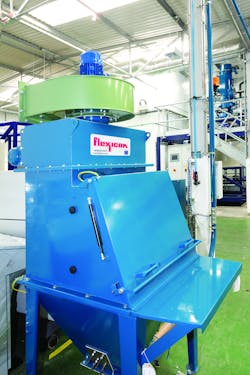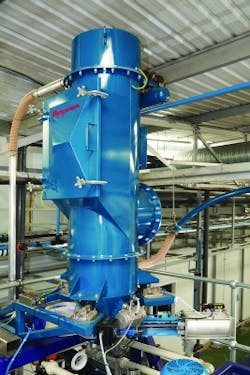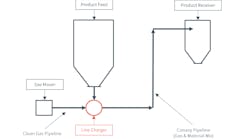The future of lithium-ion (li-ion) batteries — found in laptops, phones, hybrid cars and other applications — may be taking shape at a U.K. startup. Nexeon Ltd. built a plant at its headquarters in Abingdon, Oxfordshire, England, to produce a silicon anode it developed that significantly improves the energy density and operating life of li-ion batteries. A critical part of producing the silicon anodes involves transferring precise amounts of silicon powder and other ingredients from a bag dump station to a slurry tank for mixing in an aqueous solution, using a dilute-phase Pneumati-Con vacuum conveying system from Flexicon.
The first vertical section rises 90 degrees from the hopper outlet and connects to the second horizontal section.
The transfer is dust-free and safe. Silicon powder is combustible and can be explosive under certain conditions, so Flexicon analyzed the powder and developed the pneumatic system — including dust control and explosion protection measures.
Bag dump station contains dust
The first step in transporting the powder is manually emptying bags of silicon powder and additives into the bag dump station mounted on a floor hopper. A bag tray support provides a work surface for the operator to stage, clean and open bags.
A dust collection system — which is integral to the bag dump station — draws airborne dust through two cartridge filters. As this occurs, reverse pulse jets automatically clean the filters. Any accumulated dust gathered from the filters is returned to the hopper.
System feeds the weigh hopper
The powder flows from the bottom outlet of the floor hopper through a pickup adapter into the two-stage pneumatic conveying line.
The first vertical section rises 90 degrees from the hopper outlet and connects to the second horizontal section. This second section runs from the silicon unloading area to the main processing area.
Powders move from the bag dump station through the pneumatic conveying line to the filter receiver (rear) in the main processing area. A fully enclosed system prevents the escape of dust.
The receiving hopper empties into a slurry makeup vessel.
A side-channel blower downstream of the filter-receiver atop the receiving hopper provides a vacuum that pulls the material through the pneumatic line, improving dust control.
The fully enclosed system transfers the silicon powder virtually dust-free. Since the system operates under vacuum, even if the integrity of the enclosed system is unintentionally compromised, the silicon powder will remain within the
conveying system.
Filter receiver is isolated & safe
The filter receiver separates the silicon powder from the air stream before the powder enters the receiving hopper. Like the bag dump station, it has a reverse pulse jet system that automatically cleans the filter cartridges at timed intervals. The filter-receiver is isolated in a safe area.
This receiver is protected with an explosion-relief panel designed to exhaust the energy associated with an explosion without causing a catastrophic failure of the filter-receiver.
At the bottom outlet of the receiving hopper, a pneumatically actuated slide gate valve discharges the silicon powder into the slurry tank.
One set of load cells beneath the floor hopper at the bag dump station, in combination with load cells beneath the filter receiver, sends signals to the programmable logic controller (PLC). The PLC automates the delivery of a predetermined amount of powder to the slurry vessel.
Powders move from the bag dump station through the pneumatic conveying line to the filter receiver (rear) in the main processing area. A fully enclosed system prevents the escape of dust.
A low-level sensor near the bottom of the floor hopper signals the PLC to stop the conveyor until more material is dumped into the hopper to achieve the total batch weight.
On the receiving hopper, a high-level sensor signals the PLC to stop the conveyor if the hopper is about to overflow in the event of a system malfunction.
Reliance on a complete system avoided a piecemeal approach to equipment selection and installation and created a safe and efficient design, construction, installation and commissioning service provided by the vacuum conveying system’s manufacturer.
David Boger is vice president, Global Business Development, for Flexicon Corporation. During his tenure at Flexicon, Boger has held the positions of service engineer; applications engineer; sales manager; and vice president, sales and marketing. He holds a Bachelor of Science degree in chemical engineering from Rensselaer Polytechnic Institute, Troy, New York.
Flexicon designs and manufactures bulk handling equipment with manufacturing facilities located on four continents and a world headquarters located in Bethlehem, Pennsylvania. Flexicon manufactures a broad range of equipment including flexible screw conveyors, tubular cable conveyors, pneumatic conveying systems, bulk bag fillers, bulk bag dischargers, weigh batching systems, manual dumping stations, drum/box/container dumpers, and custom-engineered, plant-wide systems integrated with new or existing processes.





